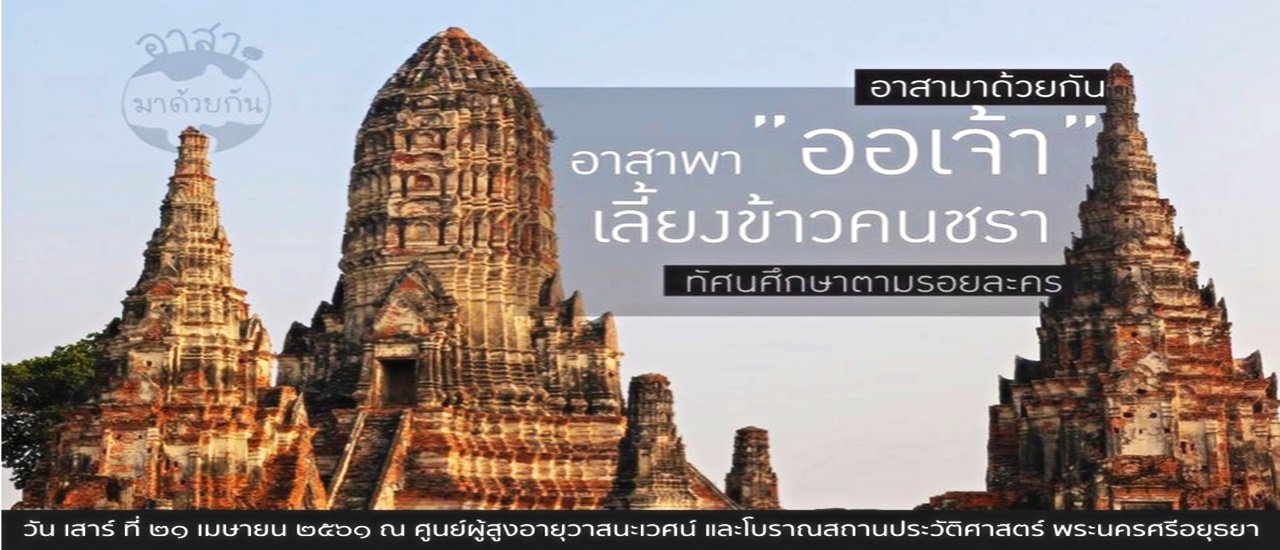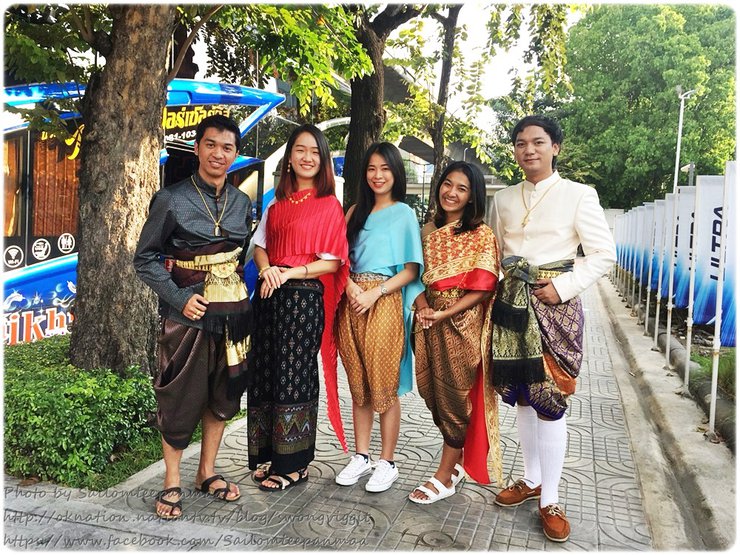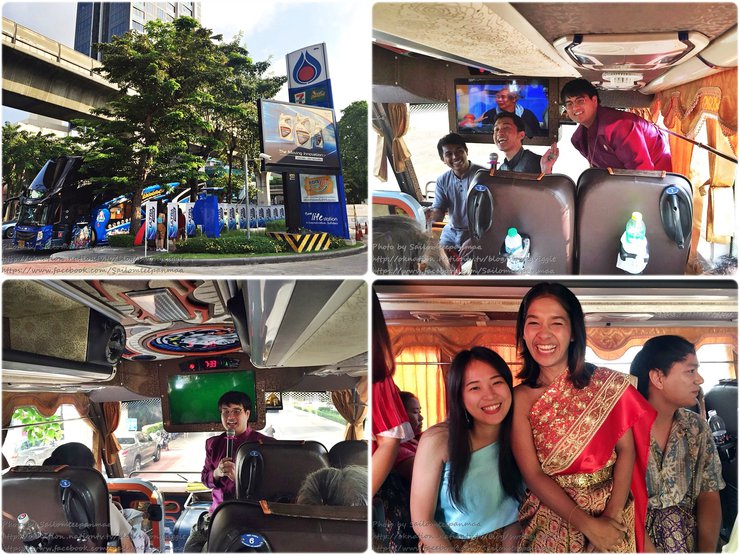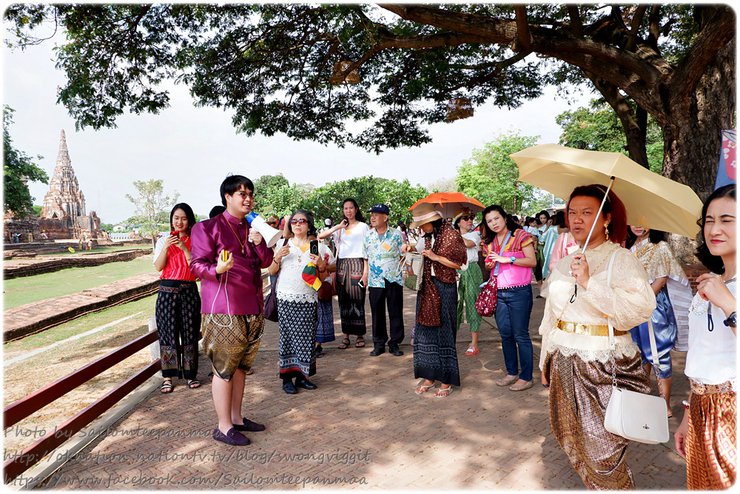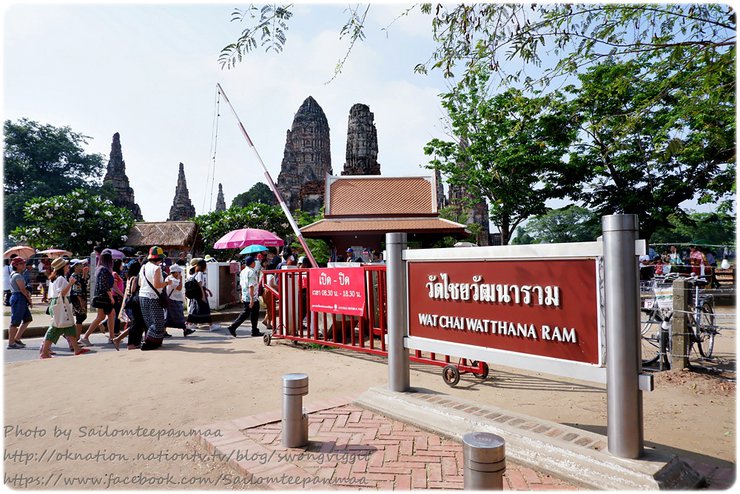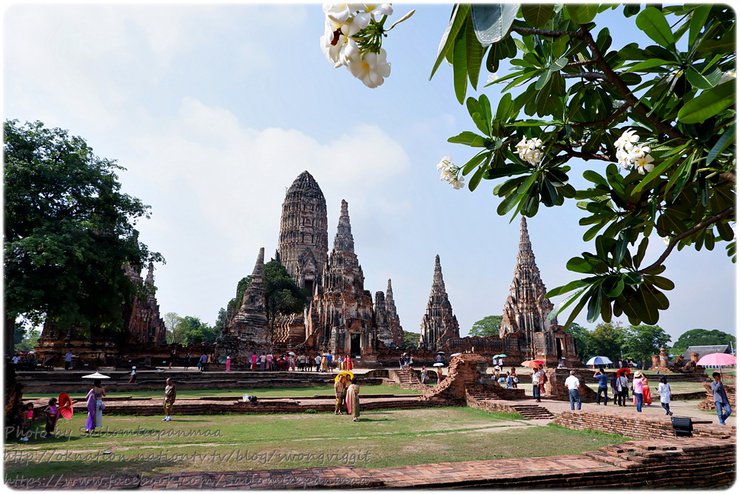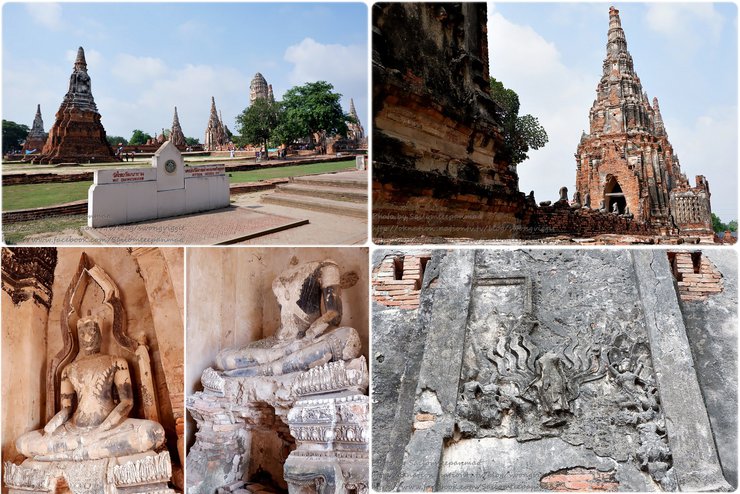
"Volunteer Together"
7:30 a.m. on April 21st, young men and women from the "Volunteer Group" stood waiting to welcome us in beautiful Thai costumes, both modern and traditional, at the PTT gas station on Sanam Pao Road.

With all members present, we embarked on our journey from Bangkok to the ancient capital of Ayutthaya. During the trip, our student volunteers introduced themselves and explained the purpose of the event.

On April 13th of each year, Thailand celebrates National Senior Citizens' Day. To mark this occasion, our group decided to organize an event to provide lunch and essential items to senior citizens at the Wasanawes Witthayakom Senior Center in Phra Nakhon Si Ayutthaya. Our goal is to bring joy and well-being to the elderly in our community.

The choice of Ayutthaya as the location for this activity is strategic. Upon completion of the activities at the Senior Citizen Center, volunteers will have the opportunity to embark on a historical tour, following the footsteps of the renowned drama "Bupphesanniwat." Additionally, they will enjoy a boat ride around the Ayutthaya Island, allowing them to immerse themselves in the atmosphere and learn about the local history from knowledgeable guides.

Typically, each group activity incurs costs between 500 and 600 baht, such as the mangrove planting activity. However, due to the relatively high cost of providing meals for the elderly, this trip costs 1,150 baht per person, which includes all activity expenses.

The car drove us along the route. Our first destination today was Wat Chaiwatthanaram. As soon as our car stopped, the volunteer students got off and stood in a line. They welcomed us and led our group to the model of Wat Chaiwatthanaram, providing a brief overview of its history.

Wat Chaiwatthanaram was built in 1630 by King Prasat Thong. The king ordered the construction on the site of his former home to dedicate merit to his mother. However, Prince Damrong Rajanubhab theorized that the temple was built to commemorate the victory over the city of Lovek, modeled after the Angkor Wat temple.

Wat Chaiwatthanaram
This sentence translates to "Wat Chaiwatthanaram" in English. It is the name of a Buddhist temple located in Ayutthaya, Thailand.
Here are some additional details about the temple:
- It was built in the 17th century during the reign of King Prasat Thong.
- It is one of the largest and most impressive temples in Ayutthaya.
- The temple is known for its unique architecture, which includes a central prang (tower) surrounded by four smaller prangs.
- The temple is a popular tourist destination and is a UNESCO World Heritage Site.
The main prang and corner prangs of Wat Chaiwatthanaram are located on the same base. The main prang follows the architectural style of early Ayutthaya period prangs, but the main prang at Wat Chaiwatthanaram has more prominent projections on the four sides. The top of the main prang may have once held a small stupa, symbolizing the Chulamani stupa atop Mount Meru.

The Ubosot in front of the main prang
The large prang is surrounded by a covered walkway, which originally had a roof. Inside the walkway, there are 120 stucco Buddha statues in the Maravijaya posture that were once gilded. They serve as a sacred boundary wall. Along the walkway, on all eight sides, there are directional and corner stupas (chedis surrounding the large prang). Inside each stupa, there are Buddha statues enshrined in glass niches, all of which are gilded. The ceilings are made of wood and are decorated with gilded patterns.

A gallery adorned with 120 stucco Buddha statues in the posture of subduing Mara, previously gilded with lacquer.

The Ubosot, located in front of the crematorium wall and the surrounding crematoria, outside the cloister, now only has a base remaining. Next to it is a twelve-angled spire stupa surrounded by three layers of walls enclosing these important ancient sites. There are also a number of smaller prang stupas that were added later.
The Eight Merus
The eight Merus, or "Meru Thid Meru Rai," surround the main prang. The interior walls of the Merus are adorned with murals depicting leaves and floral motifs, though these have faded significantly over time. The exterior walls feature stucco reliefs depicting twelve scenes from the life of the Buddha. While these reliefs are now barely visible, they were clearly discernible just two decades ago. The Merus are designed in the form of a multi-tiered prasat, rising seven levels to support the uppermost section. Their name derives from the Merus used for the funeral pyres of kings during the Ayutthaya period, which in turn were inspired by the mythical Mount Meru.

Group photo
After the briefing and scheduling a meeting time, the students gave us free time to walk around, explore, and take beautiful photos to show off. But let me tell you, Wat Chaiwatthanaram today, people are very interested in history following the drama "Bupphesanniwat". Everyone came out in Thai costumes as "Aor Chao", walking around Wat Chai with beautiful fluttering scarves.

Monument to the Three Kings: King U-Thong, the founder of Wat Phutthaisawan (the first king of Ayutthaya), King Naresuan the Great (the national savior), and his younger brother, King Ekathotsarot. Erected in 1990.
Following Wat Chaiwatthanaram, we headed to another temple featured in the drama, the one where Lady Karakade opened the Pinyo door, resisting the spell cast by Phra Ajarn Chi Pa Khao, and entered the military training camp of Muen Suntorn Thewa and Muen Ruang Ratchaphakti. This temple is Wat Phutthaisawan.

The reclining Buddha statue in the Wihan Phra Phutthaisawan, based on its artistic style and architectural features, is estimated to date back to the 22nd-23rd centuries of the Buddhist era.
During the Ayutthaya period, Wat Phutthaisawan was a significant royal temple (Royal Chronicles of Ayutthaya, 1967, p. 215). King Ramathibodi I (King U-Thong) ordered its construction three years after his ascension to the throne. The temple was built in an area known as Wiang Lek. The story of its construction is recorded in the Royal Chronicles of Ayutthaya as follows:
"In the year 715 of the Monkey, the fifth year of the Benja calendar (1896 CE), on Thursday, the 1st waxing day of the 4th lunar month, at the 2nd hour and 5 minutes of the day, His Majesty declared that the royal residence at Wiang Lek should be established as a monastery with a vihara and a great stupa, to be named Wat Phutthaisawan."

The royal chronicles mention that King U Thong, fleeing an epidemic in U Thong, first settled at Wiang Lak in the year of the Pig, 709 C.S. (1890 A.D.). After three years, seeing his people recovered and strong, he led them across the river to establish the city of Ayutthaya at its present location. The coronation ceremony marking the founding of the city took place in the year of the Rabbit, 712 C.S. (1893 A.D.). (Fine Arts Department, Royal Chronicles of Ayutthaya, Manuscript Edition, Vol. 1, 1963, p. 342)

The curved walkway and Buddha statues surrounding it, a scene from the popular drama "Love Destiny."
The Buddha statues in the Phra Rabieng were originally made of sandstone, plastered, and gilded. However, they deteriorated over time and were subsequently restored, with the new statues being sculpted in the Sukhothai style.

Main Prang (Phra Maha Chedi)
The main prang, or Phra Maha That, houses a reliquary chamber containing a stupa in the Prasat style that enshrines the relics of the Buddha. Construction began in the early Ayutthaya period.

Beyond the viharn and the main prang, outside the walls, lies the area where the popular drama "Bupphesanniwat" was filmed. This includes the scene of the military training ground and the first meeting between the teacher, Ajarn Cheephakhao, and Karakade.

The main prang retains its elegant architectural features.
The main prang of the temple, facing east, rests on a fire platform that extends to the two mandapa on the north and south sides. The overall design of the prang is influenced by Khmer architecture, which symbolizes Mount Meru or Mount Kailash, the abode of the great gods. In the original Khmer belief, the construction of the prang was a replica of the building or elements stacked in layers, representing the abode of the gods, with guardian deities stationed at each cardinal direction.

Winding Balcony

Vihara Phra Phutthaisawan
The vihara exhibits a slight inward curve resembling the hull of a small sailing ship. It features four rectangular windows on each of its longer sides, totaling six windows. A single entrance door is present. The roof structure has completely collapsed. The reclining Buddha statue faces west, directly aligned with the entrance door. Although the statue has undergone restoration, its artistic style and the architectural features of the building suggest a construction date between the 22nd and 23rd centuries of the Buddhist era.

Reclining Buddha

Leaving Wat Phutthaisawan, we headed to the main objective of this activity, which was to "feed the elderly" at the Wasana Wetsam Senior Center.

The Watsana Wesm Elderly Social Welfare Development Center was established by the disciples of Somdet Phra Ariyavongsagatayana (Vasana Maha Thera), the Supreme Patriarch of Thailand, at Wat Ratchabophit Sathit Maha Simaram. It was built as a tribute to his auspiciousness and spiritual authority after he recovered from an illness in 1985. The center aims to provide housing and support to elderly people who are facing difficulties and social problems.

Gather donated goods together.
The name "Vasanavesm" was bestowed upon this welfare institution by His Holiness the Supreme Patriarch, signifying "the abode of the blessed." This project is a collaborative effort between the Vasanavesm Foundation and the former Department of Public Welfare. Following the restructuring of government agencies, it has come under the purview of the Department of Social Development and Welfare, Ministry of Social Development and Human Security.

Listen to the lecture before the meal.
Upon arrival, we were given a brief orientation on the regulations for serving meals to the elderly residents at this nursing home. Following the orientation, we proceeded to deliver meals to the residents in their respective buildings.

The Vasana Vesm Senior Citizen Welfare Development Center
This center can accommodate 200 senior citizens and covers social welfare services for 8 central provinces. The center's funding comes from two sources: government subsidies and monthly fees collected from senior citizens and their families who can afford to contribute.

The staff informed us that the elderly residents here feel very special whenever someone comes to provide them with food. Not only do they get to enjoy a special meal outside of their regular menu, but they also feel a sense of warmth and connection from the visitors. We assisted the staff in preparing the food, portioning it into trays, and serving it to the elderly residents, all with a sense of fulfillment.

Waiting to serve food to the elderly.

Serving the elderly here, everyone is polite, well-behaved, and lovely.


After serving the food, the guests did not eat it. Instead, they asked us to sit in the middle of the dining hall to receive their gratitude, blessings, and songs in return. This gesture moved many people to tears.

Receiving Gratitude, Precepts, and Blessings from the Elderly

After finishing, the grandparents sang a song for them to listen to before having a delicious lunch together.


The officer described the living conditions of the elderly at this center.

After paying our respects to our grandparents, we returned to the main hall to hear the director of the center report on the work and various areas of the center. We also received the donations collected from the participants of the trip.

Leaving the Vasana Vecha Center with a full heart, this time we are filling our stomachs with lunch at the Chan Lorn Restaurant at the To Bak Seng Hotel. This meal is a Thai buffet, and let me tell you, the taste is truly delicious. If you're passing by, be sure to stop by and give it a try.


After lunch, we headed to Wat Phanan Choeng. We didn't have time to visit the temple, as time was limited. Some people say Ayutthaya is small and can be seen in one day, but that's not true. We boarded a boat here to cruise around Ayutthaya Island.


Embark on a boat trip to explore the islands of Ayutthaya.
As is well known, Ayutthaya is an island shaped like a junk. Therefore, in times of war, people would evacuate within the city walls, or the island of Ayutthaya itself. After the war, they would return to their livelihoods around the city as before.

Fort Phet, one of the forts mentioned in the novel "Bupphesanniwat," was the most important of the 29 forts. It was built during the reign of King Maha Thammaracha in 1580.
Our boat journey began at Wat Phanan Choeng and ended at Wat Ksatrathirat, where the three rivers, Chao Phraya, Pa Sak, and Lop Buri, converge. During the boat trip, the onboard guide and the friendly driver, P'Phon, provided insights into Ayutthaya, drawing comparisons to the historical drama "Love Destiny."

St. Joseph's Church served as the center of the Siamese Christian community during the Ayutthaya period. Its history dates back to the reign of King Narai when Pierre Lambert de la Motte and two other priests requested permission to build a Christian church and school. King Narai granted them a plot of land, which was known at that time as "Camp St. Joseph."
The church was burned down and looted during the second fall of Ayutthaya. Father Jean-Baptiste Palgu then restored the church in 1831. The current church was built during the time of Father Perro and was consecrated on November 21, 1883. The church underwent a major renovation in 2004. The current church building is over 134 years old.

The atmosphere on the boat and the snacks that the students brought for us to try.

Boat passing Wat Phutthaisawan

(Top left) The residence of Her Majesty Queen Sirikit, the Queen Mother of the Ninth Reign
(Bottom left) Wat Phutthaisawan (Right) Chedi Si Suriyothai

Board the boat at the pier of Wat Kasatrathirat.

Royal Monastery of Kshatriyarat
Wat Kshatrathirat Worawihan, originally named "Wat Kshatra" or "Wat Kshatraram", is an ancient temple built during the Ayutthaya period. The temple's main structure is a prang. During the reign of King Rama I, Prince Anurut Thewet, the Minister of the Royal Palace, and Prince Isuranurak (Kes) renovated the entire temple complex. The name was changed to "Wat Kshatrathirat" during the reign of King Chulalongkorn.

The faculty is ready to visit and pay respects to the sacred objects.

The Ubosot of Wat Kasatrathirat

Vihara Somdet Phra Phutthachan

The interior of the vihara, adorned with centuries-old murals.
The volunteers then took us to the **Wat Phra Si Sanphet**, or **Wat Phra Si Sanphet**, which was the temple of the royal palace in the ancient Ayutthaya Kingdom. It has also been declared a **"World Heritage Site"** instead of the Chao Sam Phraya Museum because there was not enough time. I agreed with this decision because visiting a museum properly requires time to learn, which we did not have.

Phra Si Sanphet Temple: A World Heritage Site
Our volunteer tour guide provided an impressive presentation on the history and significance of the ancient capital and Wat Phra Si Sanphet. They invited us to pay respects to Phra Mongkol Bophit in the nearby Vihara Phra Mongkol Bophit for good fortune. Afterwards, we were given free time to immerse ourselves in the centuries of history that surrounded us.

Phra Mongkol Bophit in the Phra Mongkol Bophit Vihara
Originally built as the residence of King Ramadhipati I, Wat Phra Si Sanphet was later transformed into a royal temple by King Borommatrailokkanat. The king designated the temple as a sacred space for significant state ceremonies. As a royal temple within the palace grounds, it was not inhabited by monks. Its establishment was motivated by the need for a temple dedicated to the royal palace.

The Lanka-style stupa
The Lanka-style stupa was built to enshrine the relics of King Borommatrailokkanat, King Ramathibodi III, and King Ramathibodi II.

Unfortunately, my time with the volunteer group came to an abrupt end due to unforeseen commitments. Despite this, the volunteers continued their activities, exploring the community's way of life and visiting the walking street market (behind the old city hall) to purchase food and necessities before returning to Bangkok. This marked the conclusion of the "Volunteer with the King: Feeding the Elderly and Exploring Historical Sites" trip, which was a truly memorable experience. The itinerary, the fellow travelers, and the shared purpose of public service all contributed to the success of the trip. Additionally, the "Volunteer Together" group provided exceptional support throughout the journey.
Who are the "Volunteer Groups"?

Volunteers United: Expanding Opportunities for Public Service
This passage describes a group of friends who, after studying and participating in activities together, decided that public service should not be limited to their close circle. They envisioned expanding opportunities for public engagement by organizing events that would invite both interested and uninterested individuals to learn about and participate in their ongoing public service efforts.
Through consistent public service activities, such as planting mangrove forests, cultivating mangrove seedlings, building weirs, and many others, you can visit, encourage, discover their identities, or participate in activities with them at Facebook Volunteer Together :: https://www.facebook.com/asa.kreate/ Give it a try, you might discover something good in yourself.
Thank you for watching.

สายลม ที่ผ่านมา
Wednesday, February 26, 2025 4:21 PM

